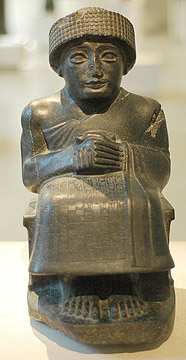Image Resource Bank
Image Gallery |  1 of 15
1 of 15 
Gudea, ensi of Lagash
This is a diorite statue of Gudea, ensi of Lagash, dedicated to the god Ningishzida, his personal god, ca. 2120 BCE (“Neo-Sumerian” period), excavated in Telloh (ancient Girsu), Iraq. Many statues of this early ruler have been found, depicting Gudea either seated or standing with his hands clasped in a form of reverence and wearing the same headgear and robe. The time of Gudea is often referred to as the “Neo-Sumerian” period because Gudea appears to hark back to an earlier form of rulership, a time when the rulers were called ensi, rather than lugal (“king”), and in contrast with the Sargonic kings, he most often depicts himself in an attitude of reverence to the gods, rather than as a conqueror.
Name: Gudea of Lagash
Material: Diorite
Size: Height: 46 cm (18 in)
Width: 33 cm (12.75 in)
Diameter: 22.5 (8.75 in)
Date: ca. 2120 BCE
Place of Origin: Excavated in Telloh
Location: Musée du Louvre, Paris, France
Registration # and Source: #: O 3293 (head) & AO 4108. Musée du Louvre, Paris, France. Department of Oriental antiquities, Richelieu Wikimedia Commons. Link to resource![]() (accessed May 7, 2010).
(accessed May 7, 2010).

 Jennie Myers
Jennie Myers
Research Associate, University of Chicago




